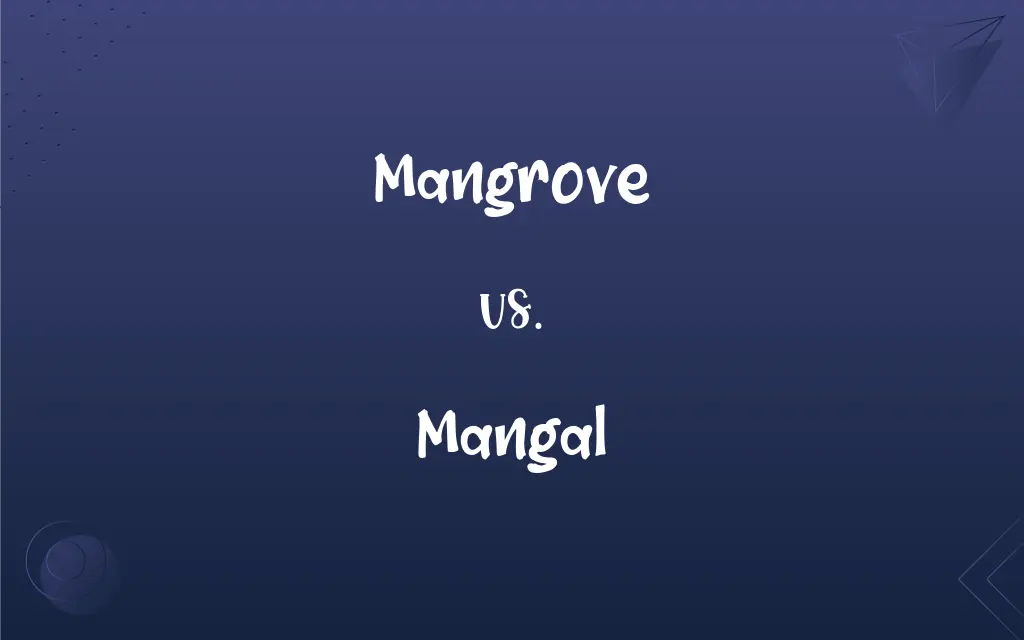Mangrove vs. Mangal: What's the Difference?
By Harlon Moss & Janet White || Updated on May 23, 2024
Mangrove refers to the individual tree species thriving in coastal intertidal zones, while mangal is the ecosystem made up of these mangrove trees and their surroundings.

Key Differences
Mangrove describes specific tree species that thrive in saline coastal habitats. These trees are known for their unique root systems that provide stability in soft, muddy soils. Mangroves play a crucial role in coastal protection and erosion control. Mangal, on the other hand, is the entire ecosystem that includes mangrove trees, the surrounding water, soil, and associated flora and fauna. This ecosystem supports a diverse range of wildlife and acts as a crucial buffer against storm surges and flooding.
Mangroves are characterized by their specialized roots, such as prop roots and pneumatophores, which aid in gas exchange and stability. While mangroves are integral to mangal environments, the mangal encompasses a broader ecological network, including tidal zones and nutrient cycles.
The importance of mangroves extends to their role in carbon sequestration and providing habitats for various species. The mangal ecosystem amplifies these benefits, offering a complex habitat that supports biodiversity and marine life, including fish nurseries and bird nesting sites.
Comparison Chart
Definition
Tree species in coastal intertidal zones
Ecosystem including mangroves and surroundings
Focus
Individual plants
Entire habitat
ADVERTISEMENT
Role
Coastal protection and erosion control
Biodiversity support and storm buffering
Root System
Specialized for stability and gas exchange
Integral part of the ecosystem
Ecological Impact
Carbon sequestration
Complex nutrient cycles and habitats
Mangrove and Mangal Definitions
Mangrove
A tree species found in coastal regions.
The mangrove's roots were visible above the waterline.
Mangal
Ecosystem including mangrove trees and surroundings.
The mangal is rich in biodiversity.
ADVERTISEMENT
Mangrove
Important for coastal ecosystem health.
Mangroves provide shelter for many marine species.
Mangal
Habitat supporting various species.
Fish often breed in the mangal.
Mangrove
Trees with unique root systems for stability.
The mangrove roots help prevent coastal erosion.
Mangal
Includes tidal zones and nutrient cycles.
Nutrient-rich waters flow through the mangal.
Mangrove
Known for their role in carbon sequestration.
Mangroves absorb large amounts of carbon dioxide.
Mangal
Comprises both flora and fauna.
Birds and fish thrive in the mangal ecosystem.
Mangrove
Plants adapted to saline environments.
Mangroves thrive in salty coastal waters.
Mangal
Acts as a buffer against storms.
The mangal protects inland areas from storm surges.
Mangrove
Any of various tropical or subtropical evergreen salt-tolerant trees or shrubs especially of the family Rhizophoraceae, forming dense thickets along tidal shores and typically having well-developed aerial roots.
Mangal
A mangrove swamp or ecosystem.
Mangrove
Any of various tropical evergreen trees or shrubs that grow in intertidal coastal brackish waters.
Mangal
A Middle Eastern-style barbecue cookout, or the barbecue grill; cooking apparatus it is cooked on.
Mangrove
A habitat with such plants; mangrove forest; mangrove swamp; mangal.
Mangrove
Any of various plants of the Rhizophoraceae family.
Mangrove
Any of various trees of the genus Rhizophora.
Mangrove
The name of one or two trees of the genus Rhizophora (Rhizophora Mangle, and Rhizophora mucronata, the last doubtfully distinct) inhabiting muddy shores of tropical regions, where they spread by emitting aërial roots, which fasten in the saline mire and eventually become new stems. The seeds also send down a strong root while yet attached to the parent plant.
Mangrove
The mango fish.
Mangrove
A tropical tree or shrub bearing fruit that germinates while still on the tree and having numerous prop roots that eventually form an impenetrable mass and are important in land building
FAQs
What is a mangrove?
A mangrove is a tree species adapted to grow in coastal intertidal zones.
What is a mangal?
A mangal is the ecosystem that includes mangrove trees, water, soil, and associated flora and fauna.
Why are mangroves important?
Mangroves help prevent coastal erosion, protect against storms, and sequester carbon.
How do mangroves differ from other trees?
Mangroves have specialized roots for stability and gas exchange in saline environments.
What benefits does the mangal provide?
The mangal supports biodiversity, acts as a storm buffer, and maintains nutrient cycles.
Can mangroves grow in freshwater?
Mangroves are primarily found in saline or brackish water, not freshwater.
What types of roots do mangroves have?
Mangroves have prop roots and pneumatophores to aid in stability and gas exchange.
Are mangroves and mangal the same?
No, mangroves are tree species, while mangal is the ecosystem that includes these trees.
What species thrive in the mangal?
Various fish, birds, and invertebrates thrive in the mangal ecosystem.
Do mangroves support marine life?
Yes, mangroves provide critical habitats for many marine species.
How does the mangal support biodiversity?
The mangal offers diverse habitats and resources for various species.
How does the mangal protect against flooding?
The mangal acts as a natural barrier, absorbing storm surges and reducing flood impact.
What human activities threaten mangroves and mangal?
Deforestation, coastal development, and pollution threaten these ecosystems.
Can mangroves be replanted?
Yes, mangroves can be replanted, but it requires specific conditions for successful growth.
How do mangroves contribute to fisheries?
Mangroves provide nursery grounds for many fish species, supporting local fisheries.
What is the role of mangroves in coastal protection?
Mangroves stabilize shorelines and reduce the impact of waves and storms.
What are pneumatophores?
Pneumatophores are specialized aerial roots that allow mangroves to breathe in waterlogged soil.
What is the ecological significance of the mangal?
The mangal maintains ecological balance through nutrient cycling and habitat provision.
Can mangroves be found in temperate regions?
Mangroves are mostly found in tropical and subtropical regions.
How do mangroves help in carbon sequestration?
Mangroves absorb and store significant amounts of carbon dioxide from the atmosphere.
About Author
Written by
Harlon MossHarlon is a seasoned quality moderator and accomplished content writer for Difference Wiki. An alumnus of the prestigious University of California, he earned his degree in Computer Science. Leveraging his academic background, Harlon brings a meticulous and informed perspective to his work, ensuring content accuracy and excellence.
Co-written by
Janet WhiteJanet White has been an esteemed writer and blogger for Difference Wiki. Holding a Master's degree in Science and Medical Journalism from the prestigious Boston University, she has consistently demonstrated her expertise and passion for her field. When she's not immersed in her work, Janet relishes her time exercising, delving into a good book, and cherishing moments with friends and family.
































































